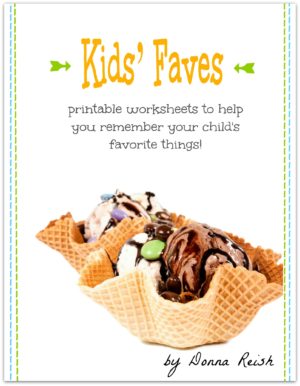by Donna | Nov 17, 2010
Because we had a few children in each room, we had to get creative in keeping all of those things that kids want to keep! Here is what we did:
Each child had two boxes—treasure boxes and “keep forever” boxes. Some were under the bed storage boxes, others were clear Rubbermaid type tubs on shelves in their closets.
Here is how they were used:
1. Treasure box—their current things that were small and that they didn’t want anybody else to get into—stationary, needlepoint, journals, gel pens, drawing pads, books, purse, etc. for girls; small toys, books, sports cards, wallet, etc. for boys. This tub was used daily by the child. It just kept their current “treasures” right where they could get to them without cluttering up the shared bedroom too much, Obviously, things that were too big went on shelves, bookcases, headboards, etc.
2. “Keep forever” box—each child had one of these (about the same sizes and storage as the treasure boxes described above). This had things that the child thought he or she wanted to keep forever—letters, cards, special pictures, art work, etc. The key to this box was that when it was overflowing, something had to go out of it.
When our older kids were little, our home was a center for hospitality and ministry much more than it is now. By keeping their special things in their bedrooms behind closed doors—and letting each child have his or her own special things—yet still having community toys that were shared, we were able to protect our kids’ privacy and an appropriate amount of “ownership” without teaching the kids to be selfish or self-focused (while teaching the importance of sharing our blessings (even toys!) with others.
by Donna | Nov 17, 2010
I once heard this older lady say that she believed the beginning of selfishness—and the end of selflessness—occurred when we started putting two bathrooms in homes. After all, this lady explained, that is when we could first stop thinking about other people who were waiting—and just focus on ourselves. While this sounds like a trite and almost laughable explanation for how we have become so selfish, there is something to be said for it.
With a large family and a small house, we did not have the luxury of deciding who would get their own rooms, who would share rooms, etc. We had four boys in one room and three girls in another. A third room, not really a full room but more of an attic type small room, became a toy room. I have a lot more to say about the accountability, relational-skills, selflessness, and deference that is learned from sharing a room with your brother(s) or sister(s), but I will save that for our 2011 PP Character Focus!
In the meantime, I will share some tips that we found workable for sharing space—both bedrooms as well as toy rooms.
1. We have always (even in our large home) had a “community” toy room—a room in which all shared toys were kept. (This included toys that we did not mind company playing with.) If you have small children and are contemplating the whole toys in each child’s bedroom vs toy room concept, I encourage you to go for the community play room. Children learn to share much better if there are not too many “mine’s” in their early years!
2. For special toys (and especially toys that we did not feel were appropriate for visiting children to play with because of sentimental value or expense—our girls collected American Girl dolls and our boys collected Legoes and Rockenbock [sp?]), we had the children keep them in their bedrooms. They seldom played in there, but that is where they were stored.
3. Obviously, if children were doing a special project (decorating something for their dolls or building an elaborate Lego creation), we had rules about the other kids touching those, etc. and they were not kept in such “community” areas.
4. Our kids’ bedrooms were mainly sleeping rooms. If the kids want to read somewhere quiet, they could go in there—and at times we used the bedrooms for “room time” for the little ones (with toy tubs that were took in there just for those occasions—see toddler and preschool posts). However, the bedrooms were mostly for sleeping, resting, and storing. (Don’t even get me started on the perils of television, videos, computers, and/or game systems in bedrooms!)
5. We used shelves with tubs (mostly clear tubs) for toys in the toy room. (More on those systems later!) The things that were for littles were down lower, so if we had company with toddlers who might put things in their mouths, the smaller toys (little, teeny people, small blocks, marbles, etc.) were all up high—and our children were taught when it was appropriate to get these down and when it was not—part of training in deference, responsibility (for those younger who might get hurt), empathy, and more!
6. Even though special toys were kept in the bedrooms, the kids usually brought them out to play with them—unless, again, they were building something or working on a special project.
Tomorrow: storing things in the bedroom—treasure boxes, keep forever boxes, and more!
by Donna | Nov 16, 2010
I know Thanksgiving is coming first—and I don’t want to diminish that, but Christmas seems to creep upon us so quickly after Thanksgiving that I wanted to start on some Christmas tips, organizing ideas, gift ideas, traditions, read alouds, and more. So here is my first installment of that!
I have some more Thanksgiving books to review—and would still love to have others’ Thanksgiving traditions if we have any guest bloggers out there who would like to contribute—so we’ll do a little of both holidays in the coming weeks. (Send Thanksgiving ideas to be used at PP 365 to cqlalady@mchsi.com asap!)
The very first tip we give in our organization workshops (and in parenting in general) is to start with yourself. The same is true of getting organized for Christmas. We might want the bedrooms cleaned for holiday guests, but if our room is a mess, the other cleaning is not going to look too inviting to our kids. If we want the kids to go through toys and get a load ready for Goodwill, but we do not clean out our things to get rid of some things, our kids might balk at the thought of their getting rid of things.
So….organize your personal space first. If you want to get recipes organized for Christmas, start now! Type a recipe a day so that when your holiday baking or cooking comes around, you will be ready. (By the way, stay tuned for some easy-to-make-with-kids holiday goodie recipes!)
I like to go through my closets and misc things first, getting things ready to move out. (We have an extremely small house, so we have had to get rid of things at least every month in order to keep the house from exploding! Thus, sorting and getting rid of things before Christmas is just a natural extension of that.) Consider what new things you might get for Christmas or what purchases you will be making. We like to take something out for most clothing items that we bring in.
Whatever it is that you have wanted to do to be more organized for Christmas, start now! An hour of wrapping gifts here and there in November will go far in relieving stress later on. Cookie dough put in the freezer on a Saturday morning in November will be that much of a head start on Christmas festivities later.
Whatever organizing that you want done—start with yourself. Start with your personal organization, then any misc things you can do ahead of time, and then start helping your kids get organized. (More tips in days to come on that.)



